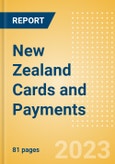The ‘New Zealand Cards and Payments - Opportunities and Risks to 2027' report provides detailed analysis of market trends in the New Zealand cards and payments industry. It provides values and volumes for a number of key performance indicators in the industry, including cards, cash, credit transfer, direct debits and cheques during the review-period (2019-23e).
The report also analyzes various payment card markets operating in the industry and provides detailed information on the number of cards in circulation, transaction values and volumes during the review-period and over the forecast-period (2023e-27). It also offers information on the country's competitive landscape, including market shares of issuers and schemes.
The report brings together the publisher's research, modeling, and analysis expertise to allow banks and card issuers to identify segment dynamics and competitive advantages. The report also covers detailed regulatory policies and recent changes in regulatory structure.
The report provides top-level market analysis, information and insights into the New Zealand cards and payments industry, including -
Current and forecast values for each market in the New Zealand cards and payments industry, including debit, credit and charge cards.
Detailed insights into payment instruments including cards, cash, credit transfer, direct debits and cheques. It also, includes an overview of the country's key alternative payment instruments.
Ecommerce market analysis.
Analysis of various market drivers and regulations governing the New Zealand cards and payments industry.
Detailed analysis of strategies adopted by banks and other institutions to market debit, credit and charge cards.
Comprehensive analysis of consumer attitudes and buying preferences for cards.
The competitive landscape of the New Zealand cards and payments industry.
The report also analyzes various payment card markets operating in the industry and provides detailed information on the number of cards in circulation, transaction values and volumes during the review-period and over the forecast-period (2023e-27). It also offers information on the country's competitive landscape, including market shares of issuers and schemes.
The report brings together the publisher's research, modeling, and analysis expertise to allow banks and card issuers to identify segment dynamics and competitive advantages. The report also covers detailed regulatory policies and recent changes in regulatory structure.
The report provides top-level market analysis, information and insights into the New Zealand cards and payments industry, including -
Current and forecast values for each market in the New Zealand cards and payments industry, including debit, credit and charge cards.
Detailed insights into payment instruments including cards, cash, credit transfer, direct debits and cheques. It also, includes an overview of the country's key alternative payment instruments.
Ecommerce market analysis.
Analysis of various market drivers and regulations governing the New Zealand cards and payments industry.
Detailed analysis of strategies adopted by banks and other institutions to market debit, credit and charge cards.
Comprehensive analysis of consumer attitudes and buying preferences for cards.
The competitive landscape of the New Zealand cards and payments industry.
Scope
- To reduce the dependence on cash, as part of its Payments Modernisation Plan 2030, Payments NZ has introduced various measures that are being adopted by commercial banks and payment services providers. The plan includes improving financial inclusion, promoting acceptance of card payments by merchants, and supporting competition and innovation to give consumers more choice in the payments space. As a result, volume, value, and frequency of card-based transactions are all set to increase over 2023e-27.
- BNPL services are gaining prominence in New Zealand as an alternative credit option, mostly driven by tech-savvy millennials. Afterpay leads the market both for online and in-store payments. In October 2022, Afterpay partnered with retailer James Pascoe Group, enabling customers to use Afterpay for purchases and split the amount into four interest-free installments. Meanwhile, Zip is also a leading player in this space, available to customers at over 3,000 online and in-store stores.
- The number of POS terminals recorded a CAGR of 2.4%, rising from 180,930 in 2019 to 199,289 in 2023e. This reflects the growing preference among consumers for electronic payment methods. In addition to conventional POS terminals, mobile POS terminals are also offered in the country. In May 2021, EFTPOS launched a portable Android-based POS terminal in New Zealand. The terminal accepts both contactless and chip and PIN-based card transactions as well as NFC-based mobile payments. Meanwhile, in August 2022, Bank of New Zealand (BNZ) launched the BNZ Pay POS mobile app, enabling merchants to covert their smartphone into a POS terminal.
Reasons to Buy
- Make strategic business decisions, using top-level historic and forecast market data, related to the New Zealand cards and payments industry and each market within it.
- Understand the key market trends and growth opportunities in the New Zealand cards and payments industry.
- Assess the competitive dynamics in the New Zealand cards and payments industry.
- Gain insights into marketing strategies used for various card types in New Zealand.
- Gain insights into key regulations governing the New Zealand cards and payments industry.
Table of Contents
- Market Overview
- Payment Instruments
- Card-Based Payments
- Ecommerce Payments
- In-Store Payments
- Buy Now Pay Later
- Mobile Payments
- P2P Payments
- Bill Payments
- Alternative Payments
- Payment Innovations
- Job Analysis
- Payment Infrastructure and Regulation
- Appendix
Companies Mentioned (Partial List)
A selection of companies mentioned in this report includes, but is not limited to:
- ANZ
- ASB
- Westpac
- BNZ
- Kiwibank
- EFTPOS
- Mastercard
- Visa
- American Express








